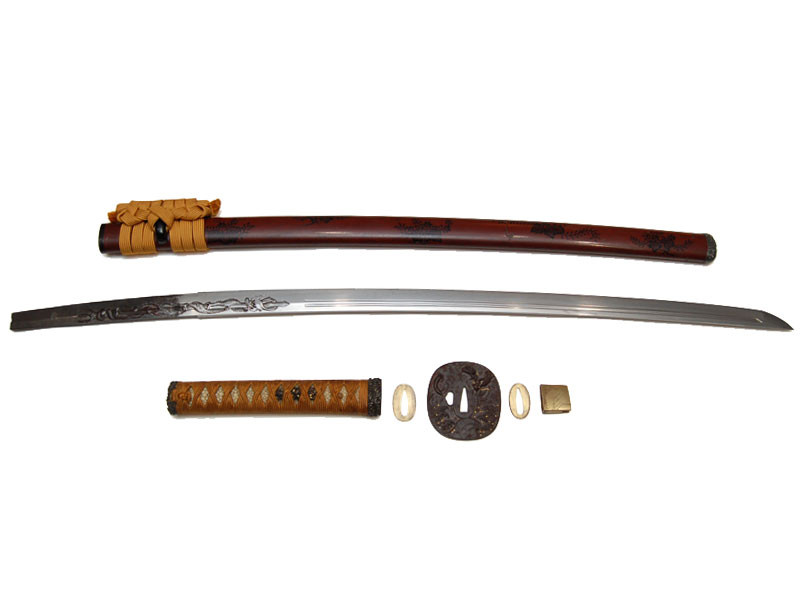






More informations about this product
<
| Total Weight | 1. 304 kg | |
| Weight without Saya | 1.020 kg | |
| Blade Weight | 0.681 kg | |
| Full length Naked Blade (Toshin) |
88.0 cm | |
| Nagasa | 66.9 cm | |
| Tsuka Length | 22.3 cm | |
| Sori (curvature) | 1.3 cm | |
| Kissaki Length | 3.7 cm | |
| Moto Haba | 3.01 cm | |
| Saki Haba | 2.12 cm | |
| Moto Kasane | A = 0.56 cm B = 0.60 cm |
|
| Saki Kasane | A = 0.39 cm B = 0.45 cm |
|
| Curvature | Tori Zori (Curvature on the middle) | |
| Type Kissaki | Elongated Chū Kissaki (Medium length). | |
| Blade Structure | Shinogi Zukuri (diamond shape) | |
| Mune | Iori Mune (Triangular) | |
| Hamon | Chū Suguha | |
| Hada | Mix of Ko-Itame and Ko-Masame very thin, nearly Muji. | |
| Horimono | On the Omote :Shin no Kurikara (Dragon wrapped around the Ken, Vajra), Futatsuji-Hi (Soei-Hi & Bo-Hi). On the Ura : Hata Hoko, Bonji Fudo Myoo, stylized Kensaku in the shape of Kuichigai-bi. As for the Symbolisms : - Shin no Kurikara is the representation of Fudo Myoo's sword with which he defeated the dragon which is also depicted. The handle is in a shape of a Vajra which is a diamond, the truth that can't be smashed by no strength nor weapon. - Hata Hoko, is the representation of Bishamonten's Jumanji Yari, along with its banner. It offers a spiritual protection to the blade's owner. - Fudo Myoo Bonji : Sanskrit writing (India), Warrior Deity, King of the immovable wisdom, symbol of the power and victory over passions and desires. - Kensaku is the representation of the rope that is able to catch the ones with violents passions and emotions. |
|
| Boshi | Komaru Hakikake (return in small shredded circle) | |
| Nakago | Length 21.1cm, O'Suriage Mchi Okuri, 2 opened Mekugi Ana, & 2 others closed off. Orikaeshi Mei 越前国住兼法 "Echizen Kuni Ju Kanenori", Taka no Ha Yasurime, Futsu Gata, Kiri Kurijiri. |
|
| Saya | Weight 0.282kg, Length 70.5cm, Sageo in Yellow orange silk, Kojiri in Metal with designs of swirling clouds. Koiguchi and Kurigata in black horn. Red bordeaux lacquered with black design of Paulownia leaves, symbol of the Toyotomi family and of the Minister of Justice. |
|
| Tsuka & Tosogu |
- Tsuka:149g, 22.3cm, one Mekugi, Braiding in Yellow orange silk in Tsumami maki type. White galuchat in high quality. Patinated Copper Menuki. Fuchi Kashira signed Shigemitsu (Kao) "重光(花押)", in Shakudo with golden nails, representing waves in deep elevations with the Takabori Zogan technique, Utshushi (faithful copy) of the Omori school. - Tsuba: Double habaki 149g, 7.9 x 8.57 x 0.40cm. Design of Dragon in the sky (Unryu 雲龍) and waves scattered with gilded Sakura petals. the dragon is in very high relief, with gilded moustaches. - Habaki: 26g, 2.98x3.12.1.1cm, Gilded copper, Yujo design. |
|
| Study & Team Review |
Study:
This blade is signed Kanenori 兼法 , 3rd generation, who was active during the Keisho era (1596-1615), Kanenori 3rd generation, comes from the Omi region, and settled up in the nearby province of Echizen.The smiths of this era and from the central region of Japan, around Mino, were forming a group called Shimosaka, and there were many movements and exchanges. In Echizen, Kanenori 兼法, (3rd gen.) became the student and the adoptive son ot the 2nd generation of Kanenori. The firs generation of this lineage was a student of Seki Kanenori and was invited in 1536 to smith for the Asakura clan in Ichijodani, Echizen. This clan and Ichijodani were totally destroyed by Oda Nobunaga in 1573. This era, Azuchi Momoyama (1573-1603), is known for the succession of the 3 reunifiers of Japan (Oda/Toyotomi/Tokugawa) and the great battle of Sekigahara. After the Sekigahara battle, Echizen was ruled by the 2nd son of Tokugawa Ieyasu, Yuki Hideyasu, attracting nobles and aristocrats, along with power and wealth, hence the presence of reknown smiths. Kanenori 兼法, (3rd gen.) was one of the 3 great smiths of Echizen, receiving the title of "Higo no Daijo", along with Yasutsugu and Sadakuni, whose blades are often ranked "Juyo Bijutsuhin", -important art object-, and having a high value. The smithing work of Kanenori is known for the following features : - Kissaki: elongated Chū Kissaki, - Hada: Ko-Itame mixed with Mokume, Jie-Nie and Chikei, - Hamon: Suguha or slighly ondulating in Notare type mixed with Ko-Gunome or Gunome, with Ashi Suganashi, - Boshi: Sugu with Midare Komi or Ko Maru Kaeri with Hakkikabe, - Yasurime: Taka No Ha before his "Higo no Daijo" title, then in Sujikai. |
|
Share your opinion
error Your review appreciation cannot be sent
feedback Report comment
check_circle Report sent
error Your report cannot be sent